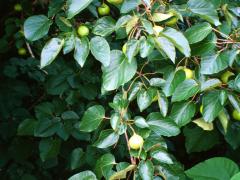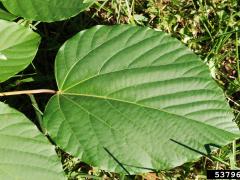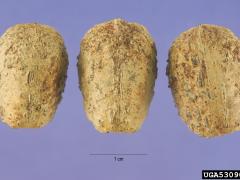Invasive Species: Vernicia fordii, Tung Oil Tree
Tung oil tree is an invasive deciduous tree that grows up to 66 ft (20 m) tall and has milky white sap. The leaves are simple, 6 to 10 in. (15.2 to 25.4 cm) long, and alternate. They are heart-shaped or have three pointed lobes. The petioles are long, and there is a distinctive red gland at the base of each leaf. The showy flowers have five white petals with red veins and bloom before the leaves emerge. The toxic fruits are reddish green, round, and 2 to 3 in. (5.1 to 7.96 cm) in diameter. Tung oil tree grows best in full sun, but it also can grow in the understory. The tree is not particularly cold tolerant. Tung oil tree invades forest edges, right-of-ways, and urban green spaces.
What are invasive species, and why should we be concerned about them?
Taxonomy: Scientific and Common Names for This Species
Euphorbiales > Euphorbiaceae > Vernicia fordii (Hemsl.) Airy-Shaw
Synonym(s): Tung oil tree, tung tree, tung nut
Vernicia fordii – USDA PLANTS Profile
Distribution Maps
tung oil tree – The reported distribution of this invasive species across the United States (Source: Invasive Plant Atlas of the United States)
Up-to-the-minute distribution maps and why they are important
Reporting This Invasive Species
What is the best way to report the occurrence of an invasive species?
How to report an invasive species sighting to EDDMapS – Early Detection & Distribution Mapping System
EDDMapS – Report an invasive species to EDDMapS.
County Extension Offices – Find your county Extension office on this map provided by USDA.
How to Identify
This invasive species can be identified by looking for the characteristics described in the paragraphs that follow.
Tree
Tung oil tree is a tree that grows up to 66 ft (20 m) tall and has milky white sap.
 |
 |
| James H. Miller, USDA Forest Service, bugwood.org | James H. Miller, USDA Forest Service, bugwood.org |
Foliage
The leaves are simple, 6 to 10 in. (15.2 to 25.4 cm) long, and alternate. They are heart-shaped or have three pointed lobes. The petioles are long, and there is a distinctive red gland at the base of each leaf.
 |
 |
| Charles T. Bryson, USDA Agricultural Research Service, bugwood.org | James H. Miller, USDA Forest Service, bugwood.org |
Flower
The showy flowers have five white petals with red veins and bloom before the leaves emerge.
|
|
 |
| Nancy Loewenstein, Auburn University, bugwood.org | Nancy Loewenstein, Auburn University, bugwood.org |
Fruit
The toxic fruits are reddish green, round, and 2 to 3 in. (5.1 to 7.96 cm) in diameter.
 |
 |
| James H. Miller, USDA Forest Service, bugwood.org | Steve Hurst, USDA NRCS PLANTS Database, bugwood.org |
Native Species That Resemble Tung Oil Tree
– Images at invasive.org
| bugwood.org | bugwood.org |
– Images at invasive.org
| bugwood.org | bugwood.org |
Additional Images for Tung Oil Tree
tung oil tree – Images at invasive.org
Learning Resources for Tung Oil Tree
Recognition Card – University of Florida, Center for Aquatic and Invasive Plants
Identification Page – University of Florida, Center for Aquatic and Invasive Plants
Additional Information, Biology, Control and Management Resources
Control and management recommendations vary according to individual circumstances. Location, habitat, weather, and a variety of other conditions are factors that help determine the best treatment choice. To find the safest and most effective treatment for your situation, consult your state’s land-grant institution. If you will use chemicals as part of the control program, always refer to the product label.
United States Land-Grant University System – Find your Land-Grant University’s College of Agriculture, University Cooperative Extension Service, or other related partner on this map provided by USDA.
Invasive Species Management Plans for Florida – University of Florida, Center for Aquatic and Invasive Plants
A Field Guide for the Identification of Invasive Plants in Southern Forests – USDA Forest Service
A Management Guide for Invasive Plants of Southern Forests – USDA Forest Service

